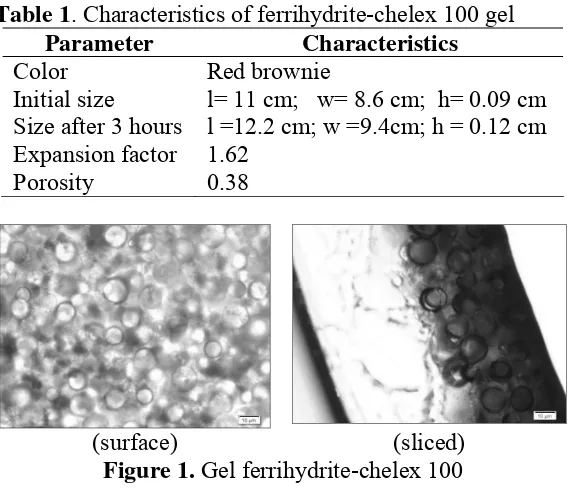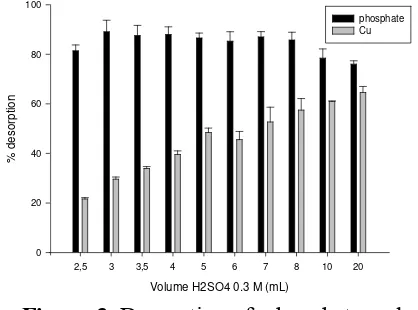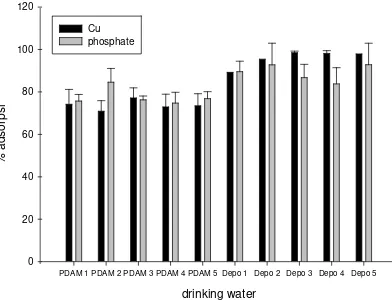The journal homepage www.jpacr.ub.ac.id ISSN : 2302 ‐ 4690
44
Removal of PO4
3-and Cu
2+Using Ferrihidrite-Chelex 100 Gel
by Adsorption Column
Risma P. Disicahyani1*, Barlah Rumhayati2, Atikah2
1
Department of Chemistry, Faculty of Science, Brawijaya University Jl. Veteran, Malang 65145, Indonesia
*
Corresponding email: [email protected]
Received 23 July 2013; Accepted 28 November 2013; Final revision completed 30 May 2014 Published online for edition May-Augus 2014
ABSTRACT
There is an global issue of contaminated drinking water sources with a heavy metals and nutrient that harm to human health, such as phosphate and Cu2+. It occurs as the byproduct or waste material from sewage population, industry and agricultural. Indonesian Government Regulation No 82 in 2001 declared maximum quantity 0.2 mg PO43-/L and 2
mg Cu/L contain in the drinking water. Resins chelex 100 and ferrihydrite reported can be applied to adsorpt PO43- and Cu2+. The adsorbent composition of ferrihydrite-chelex 100
was 1:1. This was able to displaced PO43- and Cu2+ optimally at 7.5 mL with percentage of
analyte 97.66% PO43- and 96.33% Cu2+. The highest desorption percentage for PO43- and
Cu2+ was achieved at 86.61% and 60.87% when H2SO4 0.3 M was used. In the sample of
drinking water, this adsorbent was able to removed PO43- and Cu2+ between 71 and 81%
and meanwhile from water tap sample around 84-98% at pH 5, respectivelly.
Key word: adsorption, PO43-, Cu2+, ferrihydrite-chelex 100
INTRODUCTION
Water is an essential chemical for living survival. So that drinking water supply for living must be healthy and hygienic. However, it was found often contaminated with several dangerous heavy metals particularly phosphate and Cu2+. The source contamination can be from house hold, industrial and agricultural waste. The excess phosphate contains in drinking water may cause a health problems. Bones and teeth calcium deficiency can occur as high level phosphate in the blood and also the adults will be more prone to osteoporosis [1]. While Cu(II) is highly toxic and able to cause diseases if over the limit, it will affect almost of every organ of the body, such as kidney, gastrointestinal irritation, and damage to the liver [2].
The journal homepage www.jpacr.ub.ac.id ISSN : 2302 ‐ 4690
45
with iminodiacetic acid (IDA) as active group. This functional group act as a cation exchanger on its negative charged (-CH2COO-) [6]. Meanwhile for removal of phosphate
ions, an clay commonly have been used [7], and also sludge of alum [8], however the process of the adsorption required complicated conditions. Ferrihydrite is an alternative for adsorbent in aqueous system. It has a high reactivity and large specific surface area (>200 m2/g). It was applied as an anion exchanger with its positive charged on (OH2+) [9]. Moreover, other type
of adsorbent model commonly used is plastic or glass from tube. It has a small area and requires a low flow rate of the analytes. Beside that, the diverse of adsorbent particle size in the column causes a channeling process, and reduces a capacity of the retained analyte in the adsorbent [10]. This paper discloses ferrihydrite-chelex 100 gel as adsorbent for removal of phosphate and Cu(II) ion from the drinking water sources. The effect of volume of analytes were also displayed.
EXPERIMENT
Chemicals and instrumentation Chemicals
All chemicals used as bought from the manufacturer, including acrylamide 40% (Merck), bis-acrylamide, ammonium persulfate 98% (Merck), N,N,N’,N’-tetramethylethylene diamine (TEMED) 99% (Merck), potassium dihydrogen phosphate (Merck), copper sulfate pentahydrate (Merck), hexaammonium molibdate tetrahydrate (Merck), sulfuric acid 96% (Merck), tin chloride dihydrate (Merck), nitric acid 65% (Merck), and aquadest.
Reactive phosphate was detected as phosphomolybdenum blue complex which was produced by mixing the coloring reagents of (NH4)6Mo7O24.4H2O (Merck) in acidic solution
(H2SO4, 96% Merck) and reducing agent of SnCl2.2H2O(Merck). Cu was analyzed with the
addition of HNO3 (Merck, 65%).
Instrumentation
Phosphate absorbance was measured using UV-Vis 1601 Shimadzu spectrophotometer. Cu was analysed using AA-6200 Shimadzu Atomic Absorption Spectrophotometer. Solution was measured at pH 5 by Schott Gerate CG 820 pH meter and acrylic column as a place to removal analyte.
Procedure
Preparation of ferrihydrite-chelex 100 gel
Gel solution was formed by mixing 0.3 g bis-acrylamide and 37.5 mL acrylamide 40% and stirring to homogen, and it was added distilled water to a volume of 100 mL. Meawhile ferrihydrite paste was formed by precipitation process between 25 mL FeCl3 0.2 M and
The journal homepage www.jpacr.ub.ac.id ISSN : 2302 ‐ 4690
46
Removal of phosphate 0.3 mg PO43-/L and Cu 1 mg Cu/L at pH 5
Phosphate and Cu(II) removal was conducted using acrylic columns. An ferrihydrite-chelex-100 gel disc was arranged between whatman paper discs, and the phosphate and Cu(II) solution in various volume was flown to the column. The analytes solution was prepared in volume variation such as 5.0; 7.5; 10; 15; 20; 25 and 30 mL. Then the effluent resulted was analyzed using spectrophotometer for phosphate and Cu(II) concentrations.
Elution experiments
The gel that has retained phosphate and Cu(II) was eluted using sulphuric acid 0.3 M or nitric acid 0.6 M with various volume 2.5; 3; 3.5; 4; 5; 6; 7; 8; 10 and 20 mL. The effluent resulted was analyzed using spectrophotometer.
RESULT AND DISCUSSION
Characteristics of ferrihydrite-chelex 100 gel
Resin chelex-100 and ferrihydrite was embedded into the acrylamide gel has a high adsorption capacity to the analyte. It has stability at pH solution below 11 [11]. Ferrihydrite-chelex 100 gel showed expansion/swelling indication after immersion it in distilled water up to 3 h. The characteristic of the resulted of gel adsorbent are shown in Table1.
Table 1. Characteristics of ferrihydrite-chelex 100 gel
Parameter Characteristics
Color Red brownie
Initial size l= 11 cm; w= 8.6 cm; h= 0.09 cm Size after 3 hours l =12.2 cm; w =9.4cm; h = 0.12 cm Expansion factor 1.62
Porosity 0.38
(surface) (sliced)
Figure 1. Gel ferrihydrite-chelex 100
The journal homepage www.jpacr.ub.ac.id ISSN : 2302 ‐ 4690
47
ferryhidrite and resin chelex 100 which has a large molecular weight and tends to felt down due to its gravity influence.
Removal of phosphate 0.3 mg PO43-/L and Cu 1.0 mg Cu/L at pH 5
The adsorption of analyte volume affects the mass of the adsorbed analyte. The analyte amounts is adsorbed increases with the increasing of mass, and it causes the displacement of analytes from solution to the surface of the adsorbent. It occurs continuously until the mass of the analyte in equilibrium condition. Interaction of Cu2+ with the side active of adsorbent chelex 100 (CH2COO-) has formed a stable chelate complexes constant 2.65 [13], so that
Cu2+ ions was adsorbed on the gel. Meanwhile, the phosphate ion have interaction to the cationic hydroxo (FeOH2+) sites from ferrihydrite through electrostatic interaction
Figure 2.Removal of
phosphate and Cu at various volume
Changing of the analyte volume from 5.0 to 30 mL increase the removal percentage of Cu2+ and phosphate ion. The optimum removal percentage of phosphate and Cu2+ is achieved at volume 7.5 mL. Increasing of the volumes analyte, the adsorbent was be saturated, then the ability to adsorb phosphate and Cu2+ ion decreased. The result, it was found that phosphate ion in solution can be displaced up to 97.66% meanwhile Cu2+ up to 96.93% using initial volume 7.5 mL with initial concentration 0.3 mg PO43-/L and Cu 1 mg Cu/L at pH 5.
Figure 3. Desorption of phosphate and
Cu(II) using H2SO4 0.3 M
Figure 4. Desorption of phosphate and Cu(II)
The journal homepage www.jpacr.ub.ac.id ISSN : 2302 ‐ 4690
45
drinking water
PDAM 1 PDAM 2 PDAM 3 PDAM 4 PDAM 5 Depo 1 Depo 2 Depo 3 Depo 4 Depo 5
% ad
sorp
si
0 20 40 60 80 100 120
Cu phosphate
Elution of phosphate and Cu(II)
The desorption was performed using nitric acid (0.6 M) and sulfuric acid (0.3 M). The desorption percentage was determined by calculating the amount of phosphate and Cu(II) desorbed by the acid. The results was displayed in Figure 3 and 4, respectively.
These results indicate that both nitric and sulfuric acid desorbed the phosphate retained on the gel-chelex ferrihidrit 100. It occur possibly electrostatic interaction between the phosphate and adsorbent getting weak when acidic condition or lower pH was applied. Increasing of volume of eluent increases of the desorbed phosphate, but when the volume 20 mL of phosphate likely to go down. It was predicted that Fe ions from ferrihidrite was desorpted by the acids. Fe ions in the solution could adsorb back the phosphate, so that it give negative interference during analysis of phosphate in solution [14]. Therefore, the optimum eluent was indicated in 10 mL H2SO4 0.3 M with desorption percentage of phosphate 86.61%
and 79.74% for when using HNO3 0.6 M.
Both figure 3 and 4 showed that not all of Cu2+ was desorpted from the adsorbent when using HNO3 0.6 M and H2SO4 0.3 M. The number of Cu2+ ions can be separated from resin
chelex-100 as eluent solution because of changing the charge on the adsorbent being total zero or positively charged, so that the formation of the metal chelate complex with iminodiacetic group will be disturbed and Cu2+ ions was desorpted.
Figure 5. Removal of phosphate and Cu ions in drinking water
Applications the adsorbent in drinking water
Adsorption of phosphate and Cu(II) using gel disc ferryhidrite-chelex 100 was applied to the drinking water are adjusted to pH 5. It follows the optimum pH in previous study [15]. The result is showed in Figure 5. The adsorption percentage of phosphate and Cu2+ ions from drinking water using developed adsorbent was obtained in range between 84-98% for water tap sample, meanwhile for refills water sample around 71-81%.
The journal homepage www.jpacr.ub.ac.id ISSN : 2302 ‐ 4690
46 water purification before consumption such as fitration process so that having less cation and anions impurities.
CONCLUSION
Ferrihydrite-chelex 100 gel has been developed for phosphate and Cu2+ removal. Phosphate in solution could be removed up to 97.66% meanwhile Cu2+ up to 96.93% at volume 7.5 mL with initial concentration 0.3 mg PO43-/L and 1.0 mg Cu/L at pH 5. Ion Cu2+
interact with IDA groups on the chelex 100 forms a chelate compound, while phosphate through electrostatic interaction with the active site on ferrihidrit FeOH2+. The phosphate and
Cu2+ could be desorbed from the gel using H2SO4 0.3 M and HNO3 0.6 M. Ferrihidrit-chelex
100 gel can be applied to removed Cu2+ and phosphate in the refilled drinking water approximately 71-81% and 84-98% in the taps water at pH 5.
ACKNOWLEDGMENT
Author thanks to Chemistry Post-Graduate Programe, Brawijaya University and BPKLN (Biro Perencanaan dan Kerjasama Luar Negeri) which has provided scholarships Fast Track.
REFERENCES
[1] Bitton, G., Wastewater Microbiology, 3rd edition, 2005, Jhon Willey and Sons, Inc., New Jersey
[2] Wahab, O. A, Egypt. J. Aquat. Res., 2007, ISSN: 1687-4285, 33, 1, 125-143 [3] Tsuyoshi, K., Kyue-Hyung, L., M. Oshima, Anal. Sci., 2001, 17.
[4] Ratnasari, M., dan Widiastuti, N., Proceedings of the National Seminar on Chemistry Unesa, 2011, ISBN 978-979-028-378-7
[5] Abdullah,M., Rizana, Y., dan Zakarin, M., Malaysia Journal of Analytical Sciences,
2006, 10, 1, 99-108
[6] Nobel, A., Chelex 100 and Chelex 20 Chelating Ion Resin, 2000, LIT200 Rev-Rad B. Bio Laboratorie.
[7] Auliah, A., Journal Chemica,2009, 10, 2, 14 – 23
[8] Asmawati, R., Studies of Sludge Alum to Decrease Phosphate Concentration in Fertilizer Industry, 2010, Laboratory Air Pollution, Department of Environmental Engineering, FTSP-ITS
[9] Zhao, J., Huggins, F.E., Feng, Z., and Huffman,G.P., Clays Clay Miner, 1994, 42, 6, 737–746.
[10] Zwir-Ferenc, A. and M. Biziuk, Polish J. Environ., 2006, 15, 5, 677-690.
[11] Gimpel, J., H. Zhang, W. Hutchinson and W. Davison, Anal. Chim. Acta, 2001, 448, 1-2, 93-103
[12] Davison,W and Hao Zhang, Anal. Chim. Acta, 1999, 398, 329-340
[13] Inczedy, J., Analytical Applications of Complex Equilibria, 1976, John Wiley & Sons Inc, New York.
[14] Peat, D. M. ; McKelvie, I. D. ; Matthews, G. P.; Haygarth, P. M.; Worsfold, P, J., Talanta, 1997, 45, 47-55.
[15] Rumhayati, B., Bisri, C., Kusumawati, H., and Yasmin, F., Indonesian Journal of
Chemistry, 2012, 12, 3, 287-290


